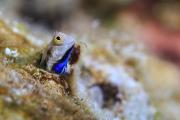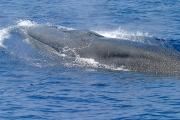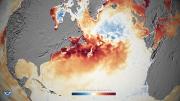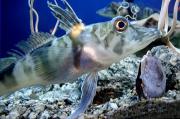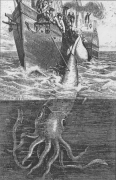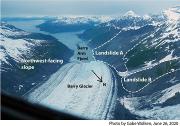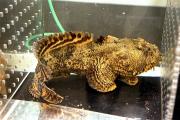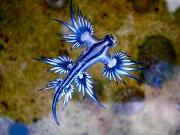Radio Program
Our regular Science and the SeaTM radio program presents marine science topics in an engaging two-minute story format. Our script writers gather ideas for the radio program from the University of Texas Marine Science Institute's researchers and from our very popular college class, Introduction to Oceanography, which we teach to hundreds of non-science majors at The University of Texas at Austin every year. Our radio programs are distributed at to commercial and public radio stations across the country.
The smallest fish in the oceans grow fast and die young. And that may keep coral reefs going. The little guys are known as cryptobenthic fish -- crypto for “hidden,” and benthic for “ocean floor.” They’re no more than a couple of inches long, and most of them are much smaller. So that allows them to “hide” among the corals.
Most islands don’t move around much. But for more than two decades, scientists and others operated from one that did. Known as T-3, the kidney-shaped island was seven miles long. It drifted close to the north pole. And eventually, it melted away. That’s because the island was made of ice -- it was a giant iceberg.
T-3 was discovered after World War II, when the military was sending airplanes across the Arctic Ocean to keep an eye on the Soviet Union. In 1952, the Pentagon built a station on the island to record the weather.
One of the most endangered groups of whales in the world hangs out in the northeastern corner of the Gulf of Mexico. It’s down to fewer than a hundred members. And although it’s protected as an endangered species, challenges in the Gulf could make it hard for the whale to recover.
One of the adages of modern science is that if a butterfly in China flaps its wings, it might lead to a hurricane weeks later in the Atlantic Ocean. There’s no way to prove or disprove that idea. But there does seem to be some evidence of a connection going the other direction: Warmer water in the northwestern Atlantic may be one factor in creating heatwaves over China, Korea, and Japan.
Eastern Asia has undergone several deadly heatwaves in recent years. A month-long hot spell in 2018 broke a century-old record in Korea, with temperatures reaching 105 degrees.
As its name implies, the icefish is cold-blooded. But it’s also clear-blooded. It’s the only known vertebrate in the world that doesn’t have red blood cells -- or the protein that gives those cells their color.
The first icefish was discovered in the 1920s in the Southern Ocean, which surrounds Antarctica. It was called the white crocodile icefish. It has a see-through body -- you can even see its brain -- plus big eyes and a long snout with a lot of teeth, like a crocodile.
No place is safe. Trash and pollution make their way into just about every nook and cranny on Earth -- including the deep oceans. A few years ago, for example, explorers found a plastic bag in the Mariana Trench, the lowest spot on the entire planet. And in 2020, scientists reported that organisms in two ocean trenches contained high levels of mercury -- most of which was produced by human activities.
The giant squid is one of the biggest animals in the oceans. A typical adult is 35 or 40 feet long, and some are even bigger. Yet it’s almost never seen. Much of what we know about the creature comes from dead ones that washed up on shore. Only a few have been photographed alive and well in the oceans.
In 2018, though, a research team easily detected the giant squid’s presence in the Sea of Japan -- through molecules of its DNA in the water. The technique could help scientists keep tabs on the squid population throughout the world.
Melting glaciers are a big problem. As their water pours into the oceans, it raises the global sea level -- a problem that will get worse in the years ahead. But they could trigger more immediate problems for people who live near them: tsunamis.
Anyone whose quiet afternoon at the beach has been disturbed by loud boats will feel sympathy for the male oyster toadfish. Boats can overwhelm its call to females. And it can get the fish all mixed up as well, causing it to change its call or even clam up for hours.
Blue dragons are among nature’s most efficient recyclers. But what they’re recycling, you don’t want. They absorb the stinging cells of the Portuguese man o’ war and similar creatures, then use them to deliver a nasty sting of their own.
Blue dragons are a type of sea slug. They’re small and elegant -- about an inch long, with wing-like structures that make them look like angels. And they have a shimmering blue color scheme that gives them their formal name: Glaucus atlanticus -- the blue one of the Atlantic.

